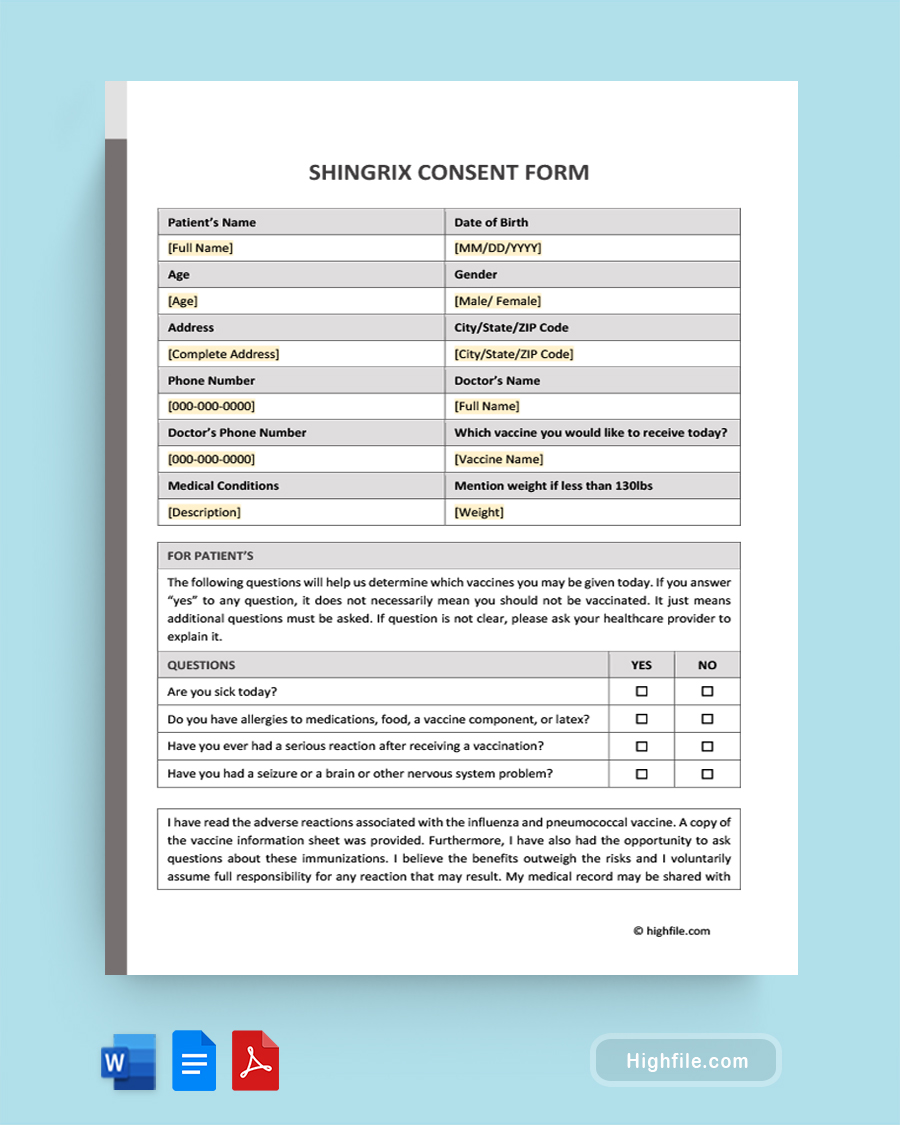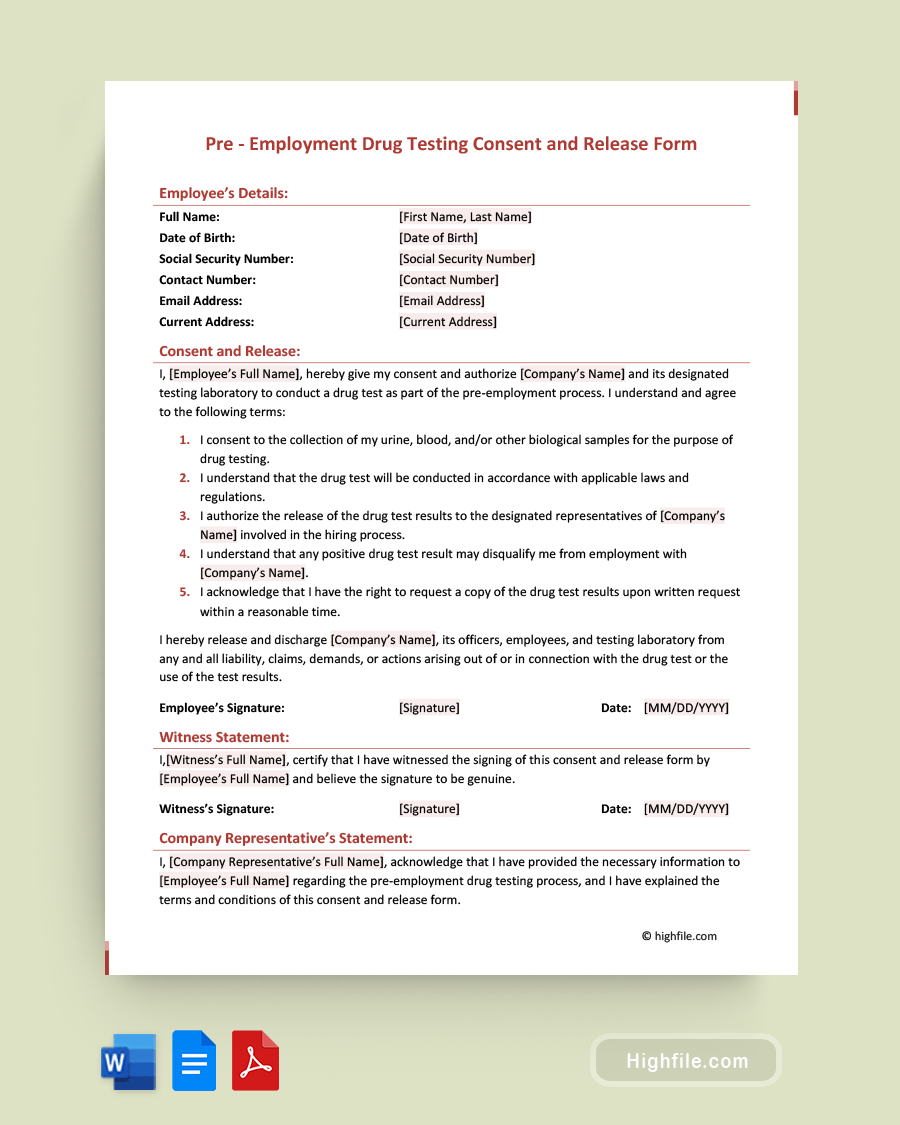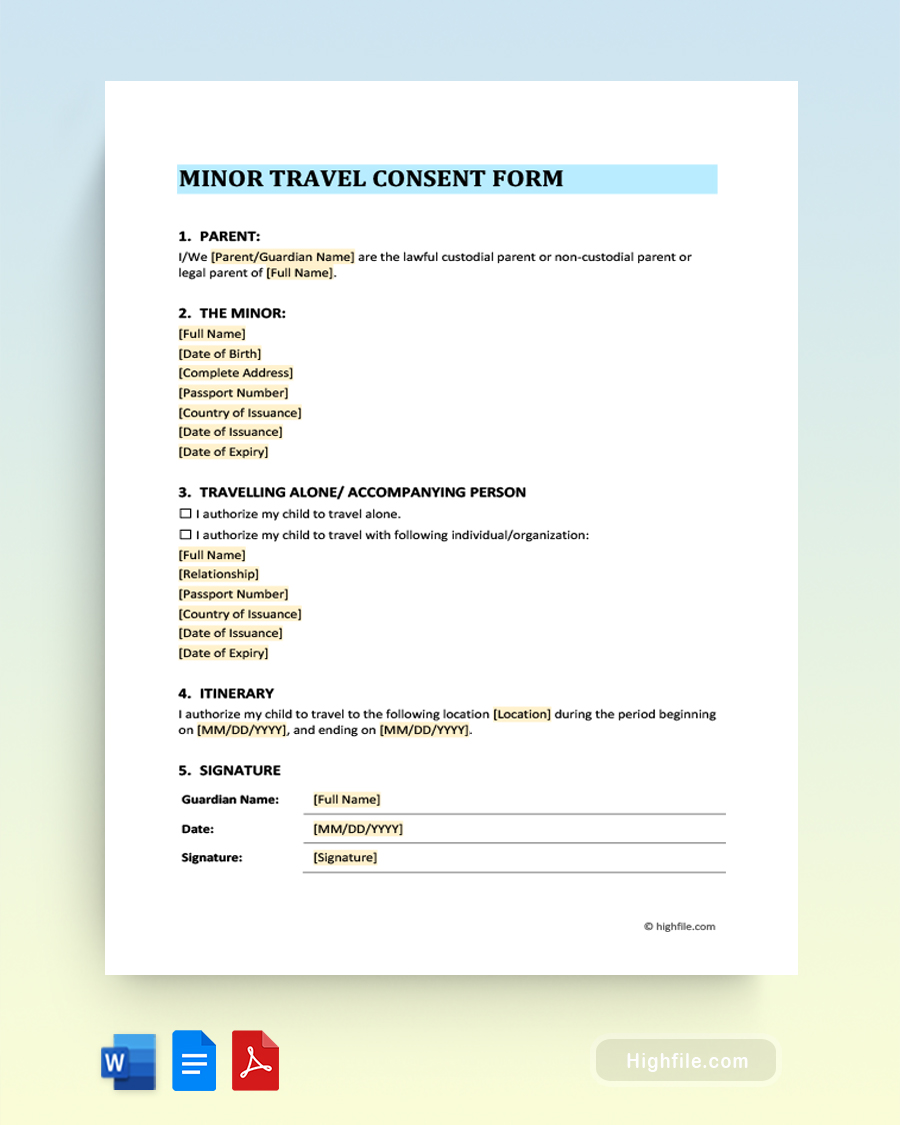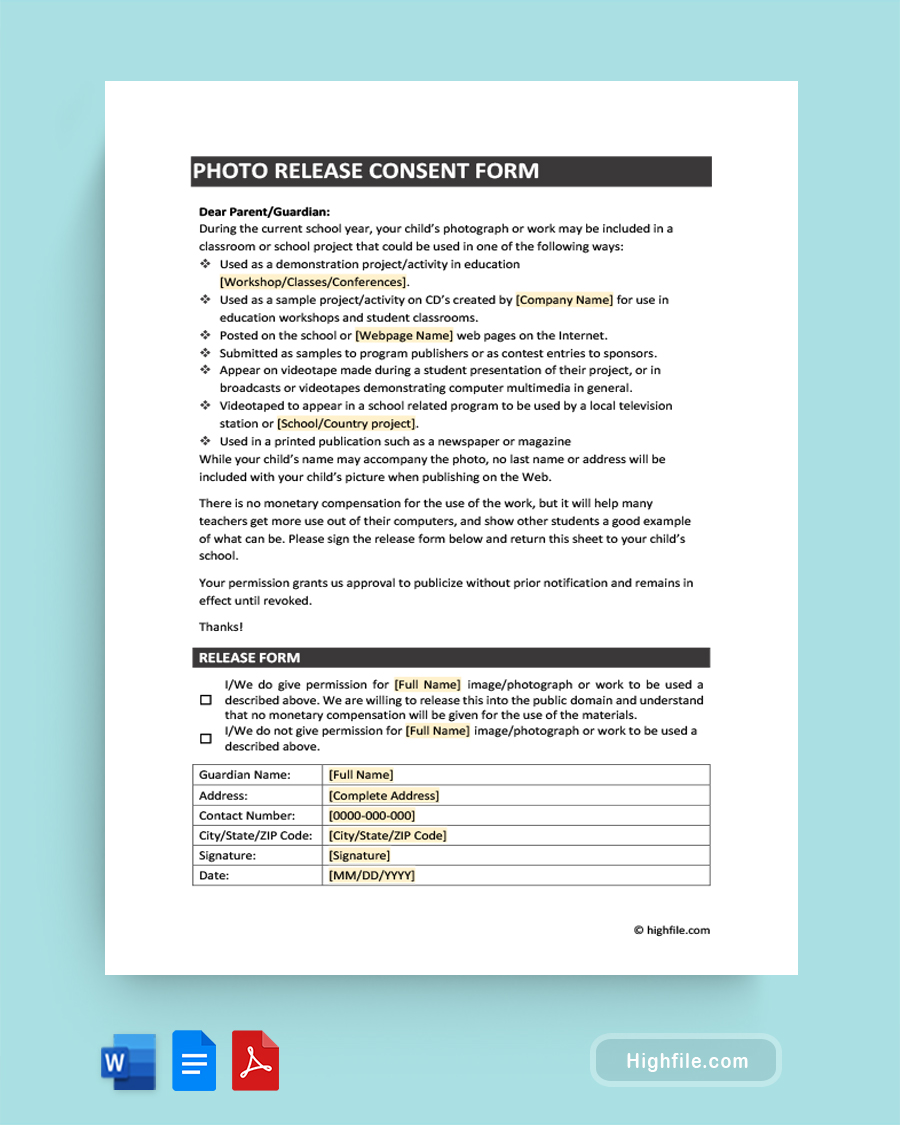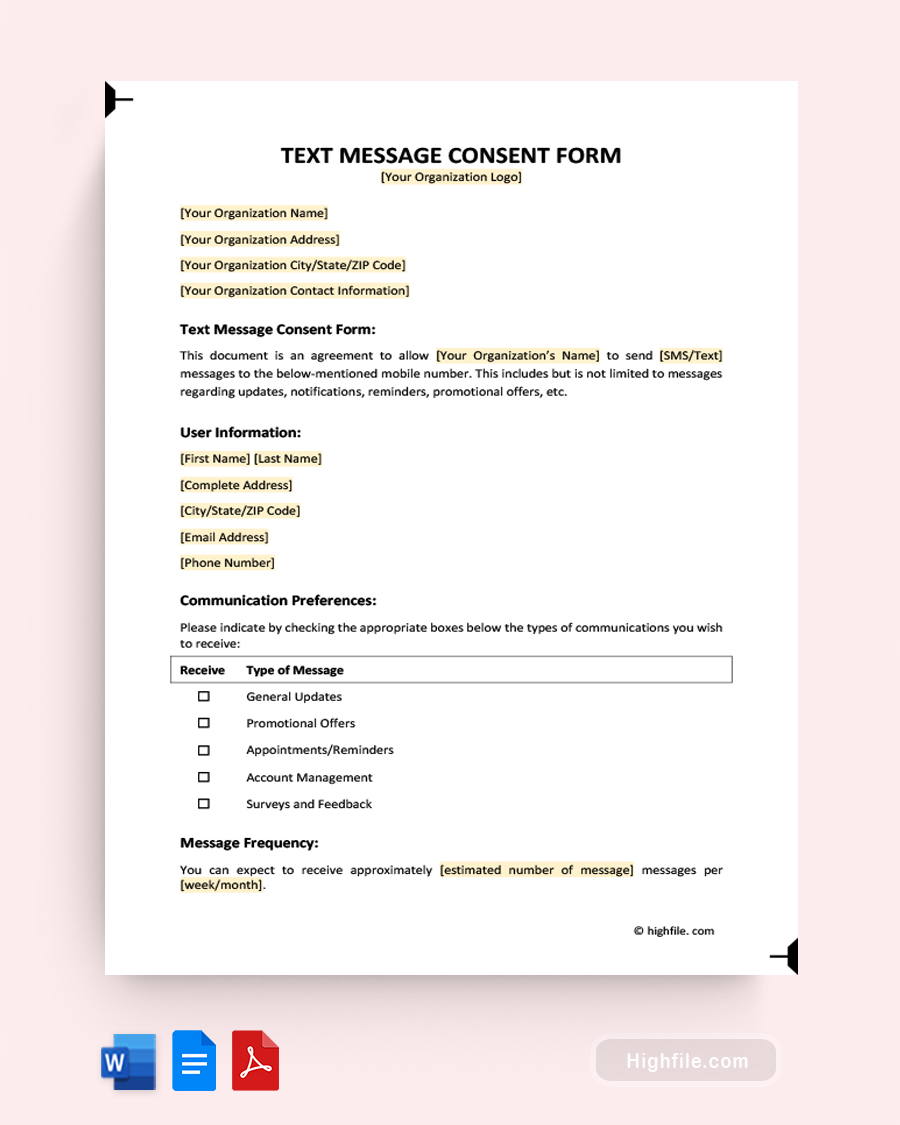Shingrix is a vaccine that can prevent the spread of shingles. It will be given in a series of 3 or 4 doses over 6 months. A Shingrix Consent Form aims to provide information about the potential risks and benefits of taking a Shingrix vaccine. It is also used to document that the person has been given complete information about the vaccine and has provided informed consent to receive it. A Shingrix Consent Form should be signed by a person who has been given comprehensive information about the vaccine and has provided informed consent to receive it. We recommend using a Shingrix Consent Form Template to help reduce errors, save time, and easily create a high-quality document for your patients.
What Is Shingrix Consent Form?
Shingrix Consent Form is a document that provides information about the risks and benefits of the Shingrix vaccine and allows a patient to give informed consent for receiving the vaccine. The form includes details about the vaccine’s components, side effects, effectiveness, and other important information. The Shingrix Consent Form provides information about the product’s components, including the type and dose of each component. The risks or benefits of receiving the vaccine, including any possible side effects and associated risks. Any other special requirements for receiving this product, such as a need for additional injections.
Fun Fact: The Shingrix Consent Form is more advanced than other vaccine-related consent documents in a unique way. This form has a place for you to indicate if you have a fear of needles. Including this in your document fosters trust and communication with medical care providers. Plus, it tells you who may need additional guidance or support during the process, making it smoother and more comfortable for everyone involved.
Why Is Shingrix Consent Form Important?
The Shingrix vaccine is used to prevent shingles in adults, and like the shot itself, the consent form has many benefits. A Shingrix consent form is a document that outlines the potential benefits, risks, and side effects of receiving this vaccine and obtains the patient’s consent for vaccination. Here are the other significant benefits of a Shingrix consent form:
- Informed Decision-Making- The Shingrix consent form provides patients with information about the vaccine, including its potential benefits, risks, and side effects. Knowing this enables patients to make an informed decision about whether to receive the vaccine or not.
- Risk Mitigation- By signing a consent form, patients acknowledge that they have received information about the vaccine and have had the opportunity to ask questions. This helps mitigate the risk of patients receiving the vaccine without fully understanding its potential benefits and risks.
- Legal Protection- A Shingrix consent form can protect healthcare providers from potential legal liability if a patient experiences an adverse outcome following vaccination. The signed consent form can serve as evidence that the patient was informed about the vaccine and voluntarily chose to receive it.
- Patient Empowerment- By providing patients with information about the vaccine and obtaining their consent, healthcare providers empower patients to take an active role in their healthcare decisions.
- Improved Patient Satisfaction- Patients who feel that they have been fully informed about their healthcare options and have had ample opportunity to ask questions are less likely to be dissatisfied with their healthcare experience.
- Improved Vaccine Uptake- By providing patients with information about the vaccine, healthcare providers can help improve vaccine uptake and decrease the risk of shingles among the adult population.
History of Shingrix and the Shingrix Consent Form
GlaxoSmithKline developed Shingrix, which received its initial FDA approval in 2017. The development of the Shingrix vaccine was based on decades of research into the biology of the varicella-zoster virus (VZV), which is the virus that causes chickenpox and shingles. As with any vaccine, the development of Shingrix involved a rigorous testing and approval process that included clinical trials to evaluate its safety and effectiveness. During these trials, researchers monitored participants for potential side effects and adverse events and evaluated the vaccine’s ability to prevent shingles and related complications.
The Shingrix consent form is an integral part of the vaccination process that evolved alongside the vaccine. It provides patients with information about the potential risks and benefits of the vaccine and allows them to make an informed decision about whether they want to proceed. From an ethical perspective, using a consent form is essential for ensuring that patients are fully informed about the potential risks and benefits of the vaccine and that they can make an informed decision about whether to proceed. Informed consent is a fundamental principle of modern medical ethics, and it requires that patients be given adequate information about their treatment options so that they can make an informed decision about their care.
The Shingrix consent form is an example of how healthcare providers can uphold the principles of informed consent and risk awareness in the context of vaccination. By providing patients with detailed information about the vaccine and allowing them to make an informed decision about whether or not to receive it, healthcare providers can ensure that patients are fully aware of the benefits and associated risks of the vaccine and that they are empowered to make the best decision for their health.
Essential Elements of Shingrix Consent Form
The essential elements of the Shingrix Consent Form are relatively straightforward. Most of the document is dedicated to collecting relevant patient information and ensuring the person receiving the vaccine understands what it is, the benefits, risks, and side effects. Below is an outline of all the essential components of a Shingrix Consent Form Template and why they belong there.
- Document Title- This tells the reader what they are looking at on sight.
- Business Logo- Logos are a standard inclusion for professional documents and provide brand continuity.
- Patient Information- The patient information collects basic data like name, age, and contact information
- Primary Doctor Information- Have the patient list their primary care physician’s name and phone number so you can send a copy of their vaccine consent for their medical records if necessary.
- Medical Conditions and Weight- This section covers current medical conditions and the patient’s weight if they are under 130 lbs.
- Current Health Questions Explanation and Checklist- Explain why you need to ask a few health questions about how they’re feeling today, then list those questions in a checklist or yes/no format.
- Consent and Waiver Statement- This covers all the basics, such as showing the patient was given reading materials and a chance to discuss questions or concerns, that they accept responsibility for the potential risks and side effects, give consent, and that they waive liability.
- Signature and Date Lines- By signing the form, the patient agrees to the terms and shows they want to receive this vaccine.
Tips for Using Your Shingrix Consent Form Template
Here are some excellent tips to keep in mind while composing your Shingrix Consent Form from our template:
- Customize: The Shingrix Consent Form Template is a great starting point, but it’s important to customize it to fit your specific needs. Consider adding or removing sections based on your organization’s policies and practices.
- Simplify: When creating your vaccine consent document, it’s essential to use plain language that is easy for patients to understand. Avoid medical jargon and technical terms that patients may not be familiar with.
- Clarity: Make sure that the risks and benefits of the vaccine are clearly outlined in the consent document. This information can help patients make an informed decision about whether or not to receive the vaccine.
- Include instructions for aftercare: Provide patients with instructions for aftercare, including what to do if they experience side effects or adverse reactions.
- Legal Considerations: Ensure your vaccine consent document complies with local laws and regulations. Consult with legal experts to ensure that you are following all applicable guidelines.
- Go Above and Beyond: Before finalizing your vaccine consent document, get input from stakeholders, including patients, healthcare providers, and legal experts. Doing this can help ensure the document is comprehensive, accurate, and easy to understand.
- Accessibility: Ensure that your vaccine consent document is accessible to patients with disabilities or those who speak languages other than English. Provide translations and accommodations as necessary.
- Review and Revise: Keep your vaccine consent document up to date with the latest information about the vaccine and any changes in local laws or regulations.
FAQs
A Shingrix Consent Form protects the patient and the practitioner. To help you get the most out of your template, we’ve answered the most frequently asked questions about this treatment below. You will find valuable facts about whether you can withdraw consent after signing, what to do if you experience side effects, disclosing medical history, and more.
You typically cannot sign the Shingrix Consent Form on behalf of someone else. The vaccine recipient must sign the form themselves or have a legal guardian or designated representative sign it on their behalf. If you are a legal representative, family member, or guardian, you may be asked to provide information about yourself on the form and indicate your relationship to the patient.
You can withdraw your consent after signing the Shingrix Consent Form. If you have signed, you can notify the healthcare provider or clinic that administered the vaccine. They will provide instructions on how to proceed with withdrawing your consent. In some instances, you may need to fill out a form and provide written notice of your withdrawal. Once your withdrawal is processed, the healthcare provider or clinic can revoke your consent and void the Shingrix Consent Form you signed. However, treatments or procedures already given cannot be reversed.
You do not need to disclose most of your medical history on the Shingrix Consent Form. However, you must talk to your healthcare provider about medical conditions or allergies before getting the Shingrix vaccine. You can consult your healthcare practitioner or a lawyer if you have any concerns about the vaccine’s safety or your HIPPA-protected medical information.
You cannot receive the Shingrix vaccine without a signed consent form. This form outlines the risks associated with receiving the vaccine and any potential side effects that may occur. Therefore, it is essential that you read and understand all of the information provided in this document before agreeing to receive the vaccine.
The Shingrix vaccine is a highly effective way to protect yourself from shingles but can also cause mild to moderate side effects in some people. If you experience any of these side effects after receiving the Shingrix vaccine, taking steps to manage them is vital. Speak with your doctor or pharmacist, follow all medical and safety instructions, and take over-the-counter medications only as recommended. In addition, you should monitor your symptoms and seek medical attention if they worsen or do not improve. By taking these steps, you can ensure that the vaccine’s benefits outweigh any potential risks.
You should receive the Shingrix vaccine at least 2 weeks before or after other vaccines. Some vaccines, such as the measles-mumps-rubella (MMR) vaccine and varicella (chickenpox) vaccine, are not recommended to be given simultaneously with Shingrix. Additionally, if you are scheduled for surgery within 2 weeks after vaccination with Shingrix, you should postpone your surgery until at least 4 weeks after immunization with Shingrix. However, you can receive other vaccines at the same time if directed to do so by your doctor.
Key Points
The Shingrix Consent Form is designed to inform patients about the vaccine and its potential risks and benefits. It allows healthcare providers to determine if the individual would be a good candidate for the vaccine and identify any potential concerns about receiving the vaccine. Plus, it also allows patients to express concerns or make requests of their provider without having to do so during a time when they may feel more vulnerable or less receptive to discussing sensitive topics like before, during, and after a vaccine injection. By signing the form, patients indicate that they have read and understood the information provided and are giving their consent to receive the vaccine. Using our Shingrix Consent Form Template can streamline the document-making process. Better still, these forms are adaptable and customizable so you can reuse, update and personalize them.
